By Chuck Zumbrun
As interviewed by Martha Mintz
Check The Specs...
NAME: Chuck Zumbrun
FARM: Zumbrun Farms
LOCATION: Churubusco, Ind.
YEARS NO-TILLING: 20
ACRES: 1,200
CROPS: Corn, soybeans, winter wheat and cereal rye
I’VE FOUND WITH many of my endeavors in no-till that I’d implement a practice for one reason, only to reap unexpected benefits and switch gears to further pursue those benefits. This applies to no-till itself, too.
Zumbruns have been farming the rolling hills northwest of Fort Wayne, Ind., at Churubusco for 100 years as of 2016. I farm it with my sister-in-law, Lana Zumbrun, and my nephew, Tom Zumbrun.
We first gave no-till a shot in 1978. It didn’t work so great for us then as we didn’t have some of the modern conveniences afforded to no-tillers today. Equipment, herbicides and hybrids hadn’t caught up with the trend yet.
By the early 1990s there were more tools to help a no-till effort be successful, so we gave it another shot.
|
Chuck Zumbrun |
Our primary incentive was to save on labor and machinery costs. As the years passed, however, we noticed many other benefits. Our soils weren’t blowing or washing away and they were actually improving.
We also live in an area that is increasingly suburban and whose water supply has been directly impacted by algae blooms in Lake Erie. Practicing no-till, which keeps soil and the nutrients it holds in place instead of down the creek, helps us maintain a positive relationship with our community.
As we started focusing more on the conservation and soil health aspects of no-till, we made some changes in our operation. On the conservation side, we installed buffer strips seeded to native grasses along our waterways and field edges bordering wooded acres.
This is a multi-layered win for us. We found from our yield monitors we weren’t getting our investment in inputs back on those acres anyway, and now those acres are populated with wild turkeys, pheasants and deer.
The filter strips along our waterways work with no-till to keep soil and nutrients out of the rivers. We also found there wasn’t a major benefit to farming right up to the edge.
A major change for us that’s had rippling effects throughout our operation was the use of cover crops.
Bait and Switch
The idea of growing some of our own nitrogen (N) was what initially attracted us to cover crops about 10 years ago. We got our feet wet seeding red clover in soybean stubble to produce N for our corn crop the coming year.
What we discovered when we were planting into the cover crops was they had significantly improved the tilth of our heavy clay soils. Our planters and drills knifed easily into the soils, which can often be a problem for us. That got our interest.
With our focus shifting more to building soil structure and soil health with covers, we switched to cereal rye as our go-to species. We seed it into corn stalks that will be rotated to soybeans.
We’ve used a variety of seeding methods to establish cereal rye. We’ve hired a custom operator with a self-propelled sprayer rigged with drop tubes and spreaders to seed it into standing corn, used aerial applications and drilled into or broadcasted on stubble after harvest.
Each method has its pros and cons. The modified sprayer made for a nice even seeding with minimal seed, but I don’t like that we had to drive across some corn to get it done.
The airplane doesn’t run over any corn, but it’s not as even of a job and, in our experience, you don’t get as consistent of a stand. That can be frustrating when you’ve paid for seed and application.
|
|
|
BUILDING LIFE. Cover crops have brought life to Chuck Zumbrun’s soils as evident by the residue being pulled down into this earthworm burrow. |
We can drill it, but this far north it can get risky. One year we drilled it and it didn’t even come up in the fall. It did come up in the spring and put on a foot of growth, but we prefer it to be better established and 4-5 feet tall when we seed into it.
Our soybeans are seeded with a John Deere 1590 no-till drill on a 7½-inch spacing. We plant directly into the living cereal rye in the spring. Running the drill over it is almost like rolling it and we easily kill 75-90% of the cover that way as long as it’s tall and growing. We then come back and hit it with a little glyphosate prior to soybean emergence to take out what’s left.
The rolling effect lays it down nicely, forming a thick mat. This has been a huge benefit to us as it’s eliminated a second herbicide treatment in our soybeans because it very effectively blocks weeds.
It’s also a nice mulch. We traditionally get too much moisture early and not enough later in the growing season. The cereal rye helps hold the moisture later in the season.
We don’t have any issues planting into cereal rye. Maybe some wrapping, but the soil just crumbles and creates a nice seedbed for us. It’s definitely improving the soil.
We don’t use auto-steer, so it can be a challenge to locate the row marker and find your way through it, but it generates interest. People often stop to ask what we’re doing and it gives us a chance to talk about why we’re doing these things and how it benefits everyone around us, not just us.
Winning Rotation
Wheat was a crop we were slowly working out of our rotation and had almost dropped completely. I rethought this strategy after one of many National No-Tillage Conferences I’ve attended over the years.
I attended a session featuring Dwayne Beck of Dakota Lakes Research Farm. He drove home the benefits of crop diversity and the importance of lengthening our rotations. I realized we were shortening our rotations by taking wheat out of the mix and decided it needed to stick around after all.
We got serious about wheat again and reversed course, increasing our acres seeded to the crop each year. As a result, our cropping rotation was lengthened from basically 2 years to 4, and now goes winter wheat, soybeans, corn, soybeans and winter wheat or cereal rye grown for seed.
We also now plant cover crops on 100% of our acres. Cover crops don’t lengthen our rotation, but do help increase our diversity.
With this added diversity and lengthened rotation, we’ve found we have practically zero issues with pests or disease. Add in the dense mat from our cereal rye cover crops that hold back weeds, and we don’t have much need for expensive traited or glyphosate-tolerant corn or soybeans. We’ve been able to shift to growing almost exclusively conventional corn and soybeans thanks to a longer rotation and cover crops.
Going conventional is a major benefit. We’re able to save a lot of money on seed and we’re able to reduce the pesticides we put into the environment. We also don’t have to worry about any secondary effect the traited crops might have on beneficial insects. And besides saving money, we can get a premium for these crops.
Wheat Focus
As we increased wheat in our rotation, we also increased the attention we give the crop. We wanted to make sure it was earning its keep.
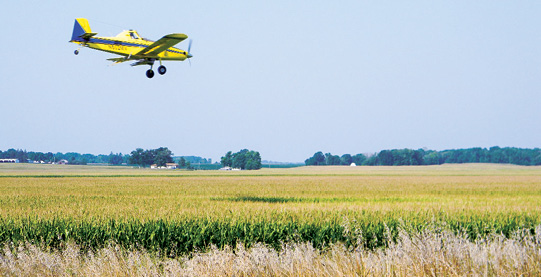
|
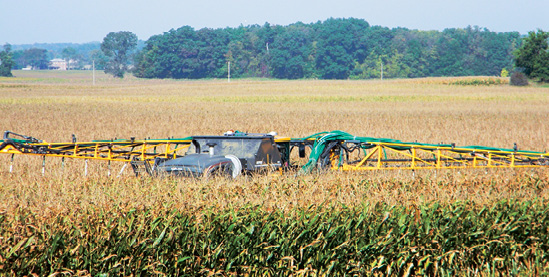
|
| EVERY ACRE. Cover crops are seeded on every acre. Various seeding methods have been used successfully, including aerial, drop-tube sprayer broadcast, drilling into stubble, broadcasting on stubble and broadcasting at sidedress. | |
When I was just a young guy, we were thrilled to get a 40-bushel wheat crop. Now, with more intensive management, we’re consistently hitting a 90-bushel average.
To achieve these higher yields we have to take a few more steps than we usually did in the past. Each crop gets two passes with a fungicide and two passes with N. We apply the same amount of N each year, but we adjust the rate per pass depending on the crop and conditions. Nitrogen is streamed on with our Hagie self-propelled sprayer.
Our first N application occurs in early spring when the snow is coming off and the ground is freezing and thawing. Prior to application we scout the field and do a tiller count. If it has been a bad fall or winter, there might not be as many tillers as we want.
We prefer each plant have at least 3 tillers. If tillers are under that threshold, we apply a larger balance of our N in that first pass. This pushes the plant to put on more tillers and more growth.
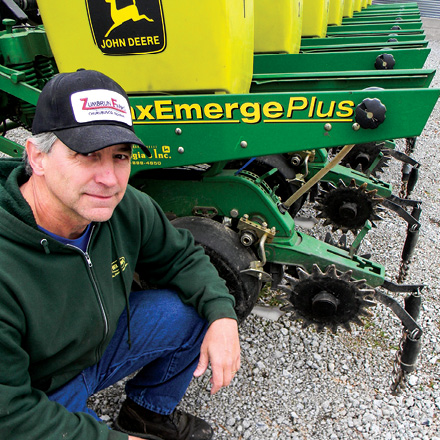
|
| PERFECT BED. For his planter and drill, Chuck Zumbrun has opted for spiked closing wheels. They tend to work better in wet conditions, he says, breaking up the sidewall instead of smearing the seed trench like a cast-iron closing wheel might. |
If we are satisfied with the number of tillers, we apply the normal rate of 15 gallons of 28-0-0 (approximately 45 pounds of actual N), leaving more N for our second application in mid to late April. Applying more N in our second pass encourages more growth as the wheat is putting on its heads. We always keep the same N budget; we just split it according to the crop’s needs.
In addition to lengthening our cropping rotation, wheat provides us with an ideal window for establishing cover crops. Because wheat is harvested in summer and we aren’t fighting the clock to beat freezing temperatures, we can use these acres for more diverse — and expensive — cover crop mixes we might not otherwise risk.
After wheat we use a summer annual mix. We’ve used a 5-way mix in the past with species such as oats, radishes, turnips and cereal rye, and in 2015 we tried a 14-way mix including sunflowers, turnips, radishes, canola, sorghum and all sorts of things.
We wanted to try a greater mix so we could add diversity and see what grows and what doesn’t. Many of these species winterkill, but we keep cereal rye in the mix so we have something green and growing until spring to keep the soils and soil life happy.
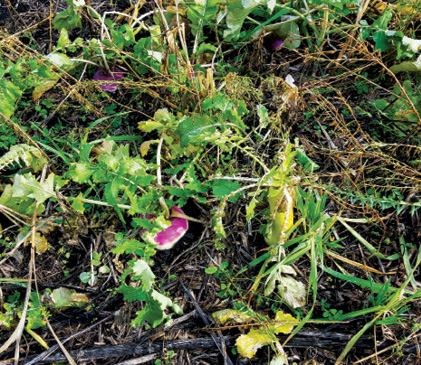
|
| HEAVY HITTERS. The diverse cover crop mixes planted behind wheat are used on soils that need an overhaul. A variety of roots and plant types break compaction and build soil structure while stimulating soil life. |
Our simpler mixes run around $12 per acre while the 14-way costs around $40 per acre. We justify this expense by only using these more expensive mixes on the 200 or so acres we plant to wheat or the cereal rye we grow for seed.
Besides having a greater chance for establishing a successful cover crop, we’re also specifically targeting our problem acres with these mixes. These are fields we feel need some help with soil structure and a boost of life, which is just what the diverse cover crop mix brings.
On our wheat acres we usually wait until after the first flush of volunteer wheat comes up to plant. We burn down the wheat and then drill the cover crop.
Checking Costs
Bringing cover crops into our no-till management picture brought an extra expense. We prefer to reduce expenses, so we’re making some efforts to do that with our cover crops. One solution is growing our own cereal rye seed. It’s definitely cheaper to grow it than to grow corn, sell corn and then buy cereal rye cover crop seed.
In an effort to cut seeding costs and another pass over the field, we’re experimenting with bolting a spinner spreader onto our sidedress bar and applying covers while sidedressing. The main issue with this method is the herbicides.
We used clover in corn and it worked very well. We were able to use Prowl H2O herbicide, which is safe for corn and clover and provided a good residual so we could control weeds and still have our cover. We got a wonderful stand and it didn’t seem to hurt our corn yield.
We’ve been able to shift to growing almost exclusively conventional corn and soybeans thanks to a longer rotation and cover crops…
The main hold up is when we’re rotating to soybeans, which really isn’t the right fit. We tried the same thing with cereal rye, but the herbicides kept the cereal rye from growing. We’ll keep experimenting so we can save a pass in the field.
While many of the benefits of cover crops are hard to measure in dollars and cents, we’ve gotten some benefits that clearly pay. Because we’re able to forgo a second herbicide pass in our crops, that saves us $15-$20 per acre in input costs. Add in the saved time and wear and tear on our sprayer, that bumps that number up to more like $20-$30 per acre. You can pay yourself back pretty quickly right there.
Our initial goal with cover crops was to cut back on applied N and fertilizer. We haven’t been able to do that just yet, but I’m taking a long-term view. It might take 10 or even 20 years to see reduced fertilizer costs, but we just have to be patient and wait for those results to come in. But I really think we’re going to see it if we continue caring for and improving our soils.
I know we are doing something good and that we won’t just benefit this year, but every year down the line. That is true of cover crops and of all the other practices we’re implementing, including no-till and lengthened rotations. We’re doing this in the hopes that this farm will continue on for another 100 years and beyond.
| Go to previous article | Go to next article |

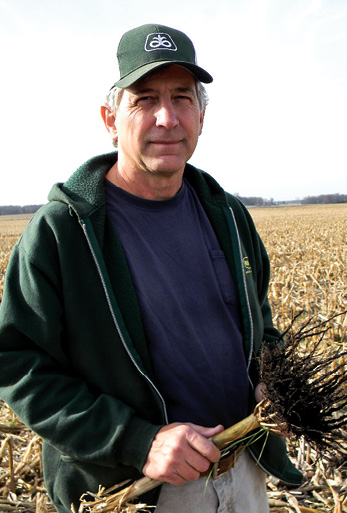
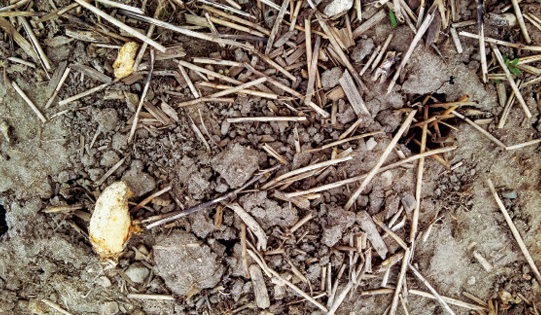





Post a comment
Report Abusive Comment